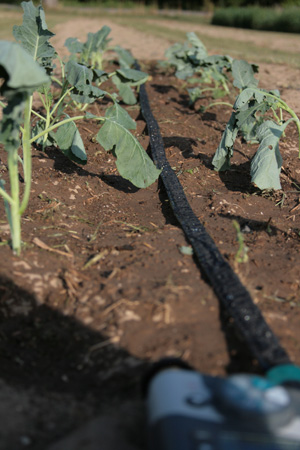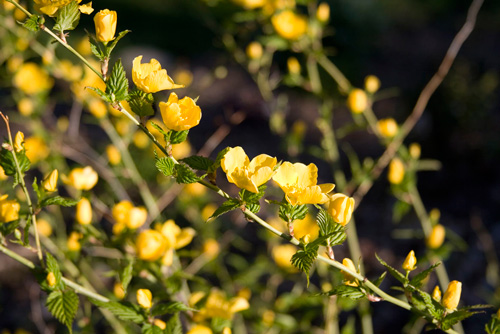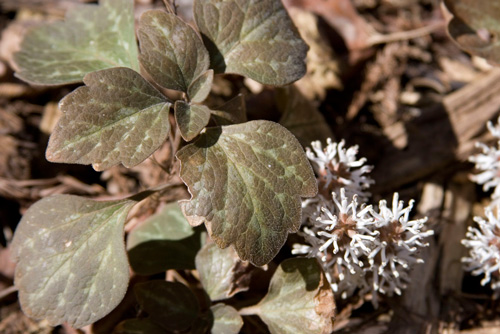by Michael Hannen with Peter House

Soaker hoses do a much better job of thoroughly soaking the soil at a deeper level than sprinklers.
In a time of shrinking resources, we can all become good stewards of our environment by employing practices of sustainability right in our own home gardens.
As the operator of a small, home-based perennial nursery, I have long adhered to sustainable practices. I use recycled pots. I make my own potting soil comprised of compost, leaf debris, and other garden scraps. I don’t use any chemical fertilizers or insecticides. My potted plants are packed into very tight extra wide rows, and remain outside all year long with no cover or greenhouse. During the growing season I don’t water my potted plants unless they show signs of wilting.
So I was surprised when I received a letter last August from the City of Rochester informing me that my water usage had increased significantly. While I was aware on some level that I was watering more than in other years, I had no idea how much more water I was really using.
The fact that our area has been experiencing moderate drought in the past few years is no doubt well known to anyone who gardens. What may not be as well understood is how the average home gardener can better conserve an ever more precious resource: clean, potable water.
One big change we can all make is in how we water our gardens. Most of us probably use sprinklers in the belief that they simulate rain, and do a good job of covering the entire garden. While this is true, they also waste water in two ways: On dry, low humidity days like we have been experiencing the past few years, much of the water evaporates before it ever reaches the soil. Additionally, water from overhead sprinklers often does not penetrate the soil sufficiently. It will often simply wet the top inch or so, without soaking in.
I discovered that the solution to this problem is soaker hoses. Because the water source is touching the ground instead of hovering five feet above it, the evaporation will be minimal. In my experience, soaker hoses do a much better job of thoroughly soaking the soil at a deeper level than sprinklers. The water department official I spoke with estimated that soaker hoses use as little as half the water that overhead sprinklers do. One final benefit of soaker hoses is that you won’t have water falling on sidewalks, patio furniture, and newly waxed cars.
Even more important than reducing the water we use is maintaining the moisture that is already in the soil. This can be done in a few ways.
While many people use commercial mulch to keep soil moist, I have found that my own garden debris is much better suited to the task. In addition to saving money, this permaculture-like technique is more sustainable. When I prune my plants, pull weeds, or cut dead plants down in the fall, I cut all of this debris into one inch sections with a pair of scissors, or pruners, and drop it right on the garden soil. In fact, I don’t just do this in the fall—I do it all year long. Anytime I deadhead or cut something back, it goes on top of the garden. I find that orange-handled Fiskars scissors from the fabric store are an ideal tool for this task.
This technique will keep new weeds at bay for two weeks or more, add nutrient rich compost to the soil, and preserve soil moisture. One caveat, however: Make sure to check plant debris for disease and unwanted seeds. Don’t despair if you miss a few seeds, as they will germinate into
more weeds to be made into compost.
If you can resist the scorn of your neighbors, you can also follow my lead and simply let autumn leaves stay where they fall. Tree leaves are excellent free mulch. Mixed with your garden debris and a little wood mulch, they break down into nutrient rich compost that will keep weeds down and hold moisture in the soil. This spongy mass also provides habitat for beneficial insects, worms, and caterpillars. Even bees and butterflies will seek refuge in this cool, moist habitat on hot days. Increasing the organic matter in the soil makes it better able to retain moisture.
As any farmer knows, perhaps the most important way to preserve soil moisture is to keep the soil planted. Barren soil leeches water into the air. So keep your garden densely planted with drought-tolerant plants. If they are habitat or pollinator plants, that’s even better.
Tall plants help preserve moisture by providing pools of shade in otherwise sunny areas. Densely planted, tall, leafy plants can create microclimates within your garden. These microclimates can support shorter plants, shade loving native plants, and perennial ground covers, all of which provide habitat, enrich the soil, and preserve moisture.

Kerria japonica

Pachysandra procumbens
The fun part of preserving water in this way is the opportunity to explore new plant material. I find tall native plants such as Vernonia noveboracensis (New York ironweed), helianthus ‘Lemon Queen’ and any other form of perennial sunflowers are excellent at creating shade. Most helianthus varieties are native to the U.S. (Warning: Jerusalem artichoke, H. tuberosus, which is native and a great food source, is also extremely invasive and nearly impossible to eradicate once you plant it on your property. If you plant it, you will have it forever.) Thalictrum pubescens and T. lucidum, Aralia racemosa, Senna hebecarpa, Rudbeckia nitda, Persicaria polymorpha (giant fleece flower), Kerria japonica, lespedeza (hardy bush pea), double hemp agrimony, and Sambucas laciniata work well also to create a canopy to shelter shade-loving plants.
For the low plants underneath your canopy, variegated lilies-of-the-valley (there are more than 50) only spread a third as much as the traditional lily-of-the-valley and are easier to maintain. Erigeron pulchellum ‘Lynhaven Carpet’, Hylomecom japonica, Anemone nemerosa, Asian Jacks-in-the-pulpit (Arisaema consanguineum, A. fargesii, etc.), and all pinellias produce leaves and flowers from early June until late October.

Polygonatum multiflorum
These plant choices would create a self-sustaining habitat garden. Using soaker hoses for minimal water use and minor weeding once established will provide a habitat garden that will feed all forms of wildlife.
As the lack of winter snow indicates, our area is not out of the woods when it comes to drought. This summer may likely be as dry as the last one. The more conscious we become of conserving water, the better able we will be to weather the dry conditions we may have to endure in the years to come.
While most of us in upstate New York will most likely not have to endure water rationing any time soon, unless we are on a well, why wait to start being a better steward of our environment and home?
Why not take the lead now and start practicing more sustainable watering practices and encouraging your neighbors to follow your lead? There is so much we can all be doing to be better stewards of our planet, and the wildlife will thank us for our efforts. I plan to take action now instead of waiting until it’s too late. I put my soaker hoses out as soon as the snow melted, and I plan to be more mindful about my water usage. How about you?
Views: 0






